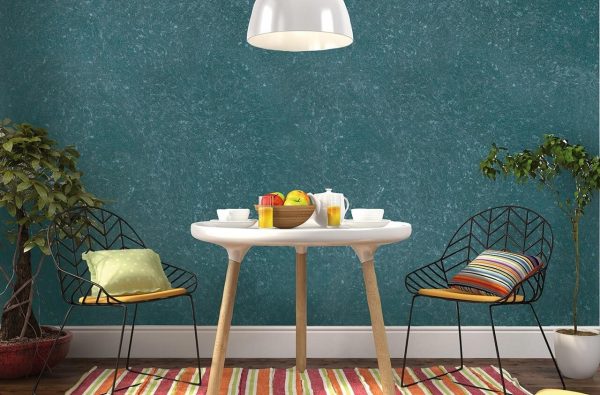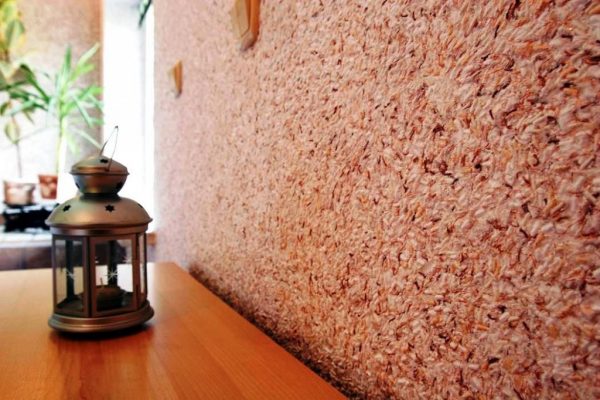Manufacturers of finishing materials offer a variety of wall coverings. Among modern decorative finishes, flocks are becoming more common. Before working with this material, you should familiarize yourself with its features, as well as the nuances of application.
- What are flocks
- Varieties of flocks
- Application Features
- Wall preparation
- Adhesive layer
- Spraying flakes
- Finish layer
- Where are acrylic chips used?
- Advantages and disadvantages

What are flocks
Flock is a multilayer texture coating that involves the sequential application of an adhesive acrylic base, solid particles of acrylic, protective varnish. The material is used for interior decoration of a house, including walls, ceilings, floors, columns, doors or individual interior items. Flocking is also called chip coating, and the concept of flock comes from the German Floken (flakes). Painted acrylic particles really look like pieces of chips. Decorative flock plaster, due to its unusual structure, is able to imitate velvet, suede or velor material.
to contents ↑In addition to its expressive appearance, flocking is durable and practical: it is resistant to mechanical, chemical and thermal environmental factors. In addition, varnished acrylic decor is easy to care for. It will be sufficient to periodically wipe the surface with a damp cloth, and in the presence of complex contaminants it is allowed to use household chemicals.
Varieties of flocks
The visual volume and texture of the finish may vary depending on the types of chips used. Possible variations in the following parameters:
- Color: plain or multicolor (up to 3-4 shades).
- Shape: round, multifaceted, elongated.
- Sizes: from 0 to 1.5 cm.
- Components of the composition: the substance may additionally contain small particles that add a fluorescent, glitter, holographic or pearlescent effect.
The combination of different types of flakes allows you to reproduce the unique design of the room.
to contents ↑Application Features
The technology for creating a colorful embossed finish involves several steps. It will be necessary to purchase the necessary materials, prepare the surface, then apply and fix the flakes.
Wall preparation
To prepare the walls for subsequent application of plaster, you must:
- Clean the surface of the old coating.
- Level the base, remove large defects and cracks.
- Primed walls.
- Get rid of settled dust.
After completion of the preparatory work, creating good adhesion, proceed to flocking.
to contents ↑Adhesive layer
A special acrylic base can be purchased ready-made at a hardware store. It is important to apply the adhesive to the base in an even, dense layer. The glue dries too quickly, so it is recommended to apply it not immediately on the entire area, but sequentially on separate areas, marking the boundaries with tape.As a tool, you can use a roller or brush.
to contents ↑Spraying flakes
Until the glue had time to dry, we proceed to applying the flakes. At this stage, you will need a special gun, similar to a spray gun. It is better to start spraying from above, gradually moving down. The tool must be kept at a distance of 0.5-1 m from the wall. For 1 square. m of surface material consumption will be approximately 150-200 g. If you didn’t distribute the chips very carefully, you can even out the layer a little with a brush, and then let the finish harden. This process takes about 12-24 hours. Crushed particles can be collected and then reused.
The first two steps are faster and more convenient to perform in pairs: one person distributes the glue, and the other immediately applies the main layer of chips.
to contents ↑Finish layer
To fix the result and make the surface smooth, it is necessary to cover the flocks with acrylic or satin varnish. First you need to wipe off loose particles with a dry brush. The protective layer may have a matte or glossy effect. The varnish will provide the flock coating with wear-resistant and moisture-proof properties.
To protect adjacent surfaces from accidental contact with acrylic material, you can glue them with a wide masking tape. It is advisable to additionally cover the floor with paper.
to contents ↑Where are acrylic chips used?
The material is used for interior decoration of premises for various purposes, you only need to correctly select the type and color of the flock.
It is better to design a bedroom or a dining room in calm monochrome tones; more saturated colors are suitable for a living room. You can highlight one wall with a bright background, and the rest painted in pastel colors. Practical and eco-friendly decoration suitable even for a child’s room. For kids, you can choose a colorful or shiny coating, and for teenagers, a design with a metallic effect is suitable. The rooms where bars, clubs or cafes are located can be decorated with fluorescent or glitter mixtures.
to contents ↑Flock plaster should also fit into the general style of the room, in harmony with furniture, textiles, flooring. For example, a combination of black and white flocks will go well with a modern interior.
Advantages and disadvantages
Flocking has a number of advantages compared to other types of finishes, namely:
- high strength, wear resistance;
- resistance to environmental factors: ultraviolet, humidity, temperature;
- masking abilities: perfectly hides small irregularities of the walls;
- simplicity in leaving;
- long service life;
- excellent heat-insulating qualities;
- variety of colors and shapes;
- easy procedure for eliminating damage on the surface of the flock;
- universality of application;
- safety: does not emit toxic substances, complies with environmental standards.
Disadvantages - the high cost of the material, the relative complexity of its application, as well as the need to purchase a special spray.
Even if you have never heard of this coating, we recommend that you look closely at it. After all, flocking is a unique combination of originality, practicality and comfort, which can decorate any room in your home.











